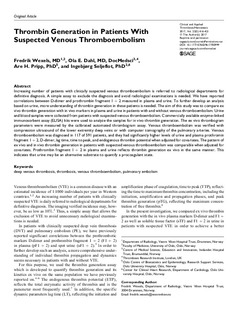| dc.contributor.author | Wexels, Fredrik | |
| dc.contributor.author | Dahl, Ola Einar | |
| dc.contributor.author | Pripp, Are Hugo | |
| dc.contributor.author | Seljeflot, Ingebjørg | |
| dc.date.accessioned | 2018-05-30T14:22:19Z | |
| dc.date.available | 2018-05-30T14:22:19Z | |
| dc.date.created | 2017-08-23T11:38:10Z | |
| dc.date.issued | 2017 | |
| dc.identifier.citation | Clinical and applied thrombosis/hemostasis. 2017, 23 (5), 416-421. | nb_NO |
| dc.identifier.issn | 1076-0296 | |
| dc.identifier.uri | http://hdl.handle.net/11250/2499832 | |
| dc.description.abstract | Increasing number of patients with clinically suspected venous thromboembolism is referred to radiological departments for definitive diagnosis. A simple assay to exclude the diagnosis and avoid radiological examinations is needed. We have reported correlations between D-dimer and prothrombin fragment 1 + 2 measured in plasma and urine. To further develop an analysis based on urine, more understanding of thrombin generation in these patients is needed. The aim of this study was to compare ex vivo thrombin generation with in vivo markers in plasma and urine in patients with and without venous thromboembolism. Urine and blood samples were collected from patients with suspected venous thromboembolism. Commercially available enzyme-linked immunosorbent assay (ELISA) kits were used to analyze the samples for in vivo thrombin generation. The ex vivo thrombogram parameters were measured by the calibrated automated thrombogram assay. Venous thromboembolism was verified with compression ultrasound of the lower extremity deep veins or with computer tomography of the pulmonary arteries. Venous thromboembolism was diagnosed in 117 of 591 patients, and they had significantly higher levels of urine and plasma prothromin fragment 1 + 2, D-dimer, lag time, time to peak, and endogenous thrombin potential when adjusted for covariates. The pattern of ex vivo and in vivo thrombin generation in patients with suspected venous thromboembolism was comparable when adjusted for covariates. Prothrombin fragment 1 + 2 in plasma and urine reflects thrombin generation ex vivo in the same manner. This indicates that urine may be an alternative substrate to quantify a procoagulant state. | nb_NO |
| dc.description.sponsorship | The author(s) received no financial support for the research, authorship, and/or publication of this article. | nb_NO |
| dc.language.iso | eng | nb_NO |
| dc.relation.uri | http://journals.sagepub.com/doi/10.1177/1076029617700999 | |
| dc.rights | Navngivelse 4.0 Internasjonal | * |
| dc.rights.uri | http://creativecommons.org/licenses/by/4.0/deed.no | * |
| dc.subject | deep venous thrombosis | nb_NO |
| dc.subject | thrombosis | nb_NO |
| dc.subject | venous thromboembolism | nb_NO |
| dc.subject | pulmonary embolism | nb_NO |
| dc.title | Thrombin Generation in Patients with Suspected Venous Thromboembolism | nb_NO |
| dc.type | Journal article | nb_NO |
| dc.type | Peer reviewed | nb_NO |
| dc.description.version | publishedVersion | nb_NO |
| dc.source.pagenumber | 416-421 | nb_NO |
| dc.source.volume | 23 | nb_NO |
| dc.source.journal | Clinical and applied thrombosis/hemostasis | nb_NO |
| dc.source.issue | 5 | nb_NO |
| dc.identifier.doi | 10.1177/1076029617700999 | |
| dc.identifier.cristin | 1488107 | |
| cristin.unitcode | 1991,1,2,0 | |
| cristin.unitname | Avd Forskning | |
| cristin.ispublished | true | |
| cristin.fulltext | original | |
| cristin.qualitycode | 1 | |

